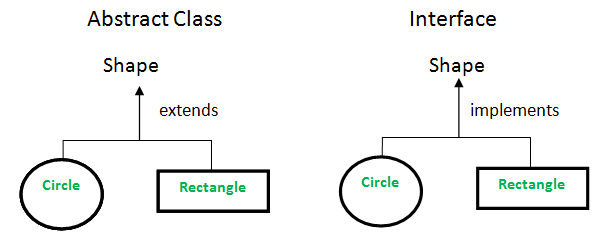先决条件–接口, 抽象类
抽象:隐藏功能的内部实现, 仅向用户显示功能。即它的工作原理(显示), 工作原理(隐藏)。都抽象类和接口用于抽象。
抽象类与接口
- 方法类型:接口只能具有抽象方法。抽象类可以具有抽象和非抽象方法。从Java 8开始, 它还可以具有默认方法和静态方法。
- 最终变量:在Java接口中声明的变量默认为final。抽象类可能包含非最终变量。
- 变量类型:抽象类可以具有最终变量, 非最终变量, 静态变量和非静态变量。接口只有静态变量和最终变量。
- 实现抽象类可以提供接口的实现。接口无法提供抽象类的实现。
- 继承与抽象:可以使用关键字” implements”来实现Java接口, 而可以使用关键字” extends”来扩展抽象类。
- 多种实现:一个接口只能扩展另一个Java接口, 一个抽象类可以扩展另一个Java类并实现多个Java接口。
- 数据成员的可访问性:默认情况下, Java接口的成员是公共的。 Java抽象类可以具有类成员, 例如private, protected等。

//Java program to illustrate the
//concept of abstract class
import java.io.*;
//abstract class
abstract class Shape
{
//declare fields
String objectName = " " ;
Shape(String name)
{
this .objectName = name;
}
//declare non-abstract methods
//it has default implementation
public void moveTo( int x, int y)
{
System.out.println( this .objectName + " " + "has been moved to"
+ " x = " + x + " and y = " + y);
}
//abstract methods which will be
//implemented by its subclass(es)
abstract public double area();
abstract public void draw();
}
class Rectangle extends Shape
{
int length, width;
//constructor
Rectangle( int length, int width, String name)
{
super (name);
this .length = length;
this .width = width;
}
@Override
public void draw()
{
System.out.println( "Rectangle has been drawn " );
}
@Override
public double area()
{
return ( double )(length*width);
}
}
class Circle extends Shape
{
double pi = 3.14 ;
int radius;
//constructor
Circle( int radius, String name)
{
super (name);
this .radius = radius;
}
@Override
public void draw()
{
System.out.println( "Circle has been drawn " );
}
@Override
public double area()
{
return ( double )((pi*radius*radius)/2 );
}
}
class GFG
{
public static void main (String[] args)
{
//creating the Object of Rectangle class
//and using shape class reference.
Shape rect = new Rectangle( 2 , 3 , "Rectangle" );
System.out.println( "Area of rectangle: " + rect.area());
rect.moveTo( 1 , 2 );
System.out.println( " " );
//creating the Objects of circle class
Shape circle = new Circle( 2 , "Cicle" );
System.out.println( "Area of circle: " + circle.area());
circle.moveTo( 2 , 4 );
}
}输出如下:
Area of rectangle: 6.0
Rectangle has been moved to x = 1 and y = 2
Area of circle: 6.28
Cicle has been moved to x = 2 and y = 4在这种情况下, 矩形和圆形之间没有任何通用代码, 因此可以使用界面。
看到这个……
//Java program to illustrate the
//concept of interface
import java.io.*;
interface Shape
{
//abstract method
void draw();
double area();
}
class Rectangle implements Shape
{
int length, width;
//constructor
Rectangle( int length, int width)
{
this .length = length;
this .width = width;
}
@Override
public void draw()
{
System.out.println( "Rectangle has been drawn " );
}
@Override
public double area()
{
return ( double )(length*width);
}
}
class Circle implements Shape
{
double pi = 3.14 ;
int radius;
//constructor
Circle( int radius)
{
this .radius = radius;
}
@Override
public void draw()
{
System.out.println( "Circle has been drawn " );
}
@Override
public double area()
{
return ( double )((pi*radius*radius)/2 );
}
}
class GFG
{
public static void main (String[] args)
{
//creating the Object of Rectangle class
//and using shape interface reference.
Shape rect = new Rectangle( 2 , 3 );
System.out.println( "Area of rectangle: " + rect.area());
//creating the Objects of circle class
Shape circle = new Circle( 2 );
System.out.println( "Area of circle: " + circle.area());
}
}输出如下
Area of rectangle: 6.0
Area of circle: 6.28什么时候使用什么?
如果以下任何一种情况适用于你的情况, 请考虑使用抽象类:
- 在Java应用程序中, 有一些相关的类需要共享一些代码行, 然后可以将这些代码行放入抽象类中, 并且所有这些相关类都应扩展此抽象类。
- 你可以在抽象类中定义非静态或非最终字段, 以便通过一种方法可以访问和修改它们所属的对象的状态。
- 你可以期望扩展抽象类的类具有许多公共方法或字段, 或者需要除public(例如protected和private)之外的访问修饰符。
如果以下任何一种情况适用于你的情况, 请考虑使用接口:
- 这是完全抽象的, 在接口中声明的所有方法都必须由实现此接口的类来实现。
- 一个类可以实现多个接口。这称为多重继承。
- 你想指定特定数据类型的行为, 但不关心谁实现了它的行为。
如果发现任何不正确的地方, 或者想分享有关上述主题的更多信息, 请写评论。
 srcmini
srcmini
评论前必须登录!
注册